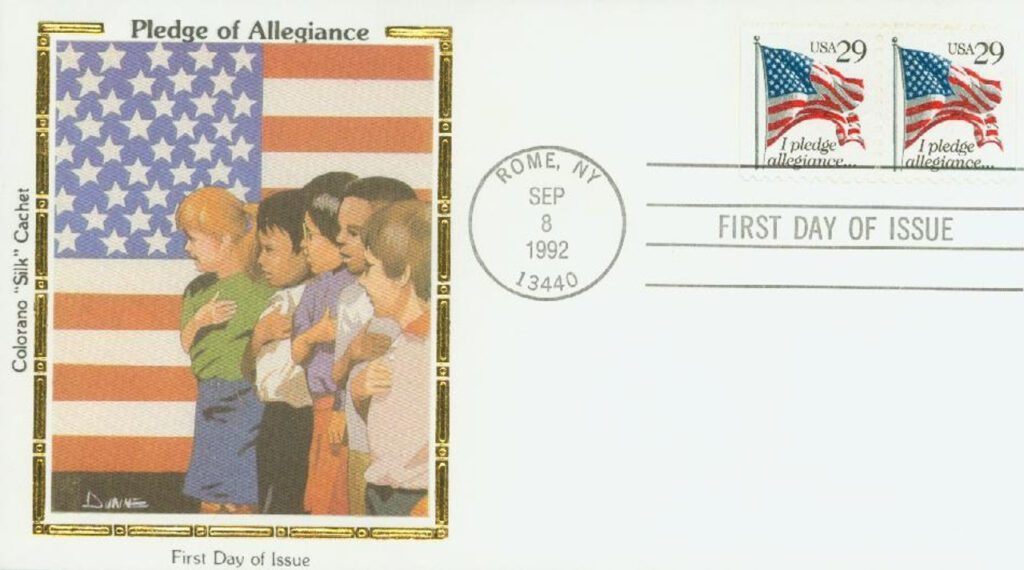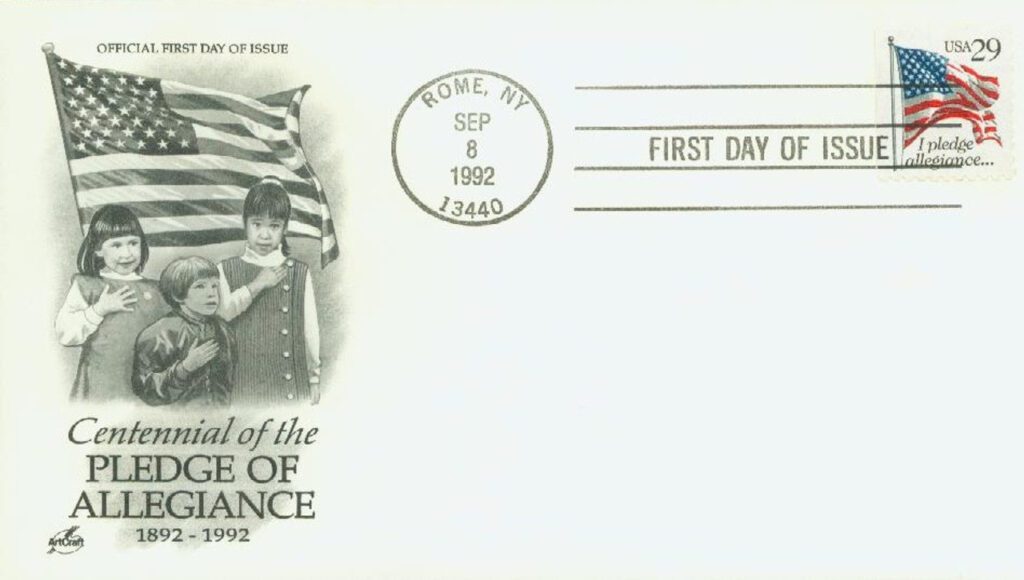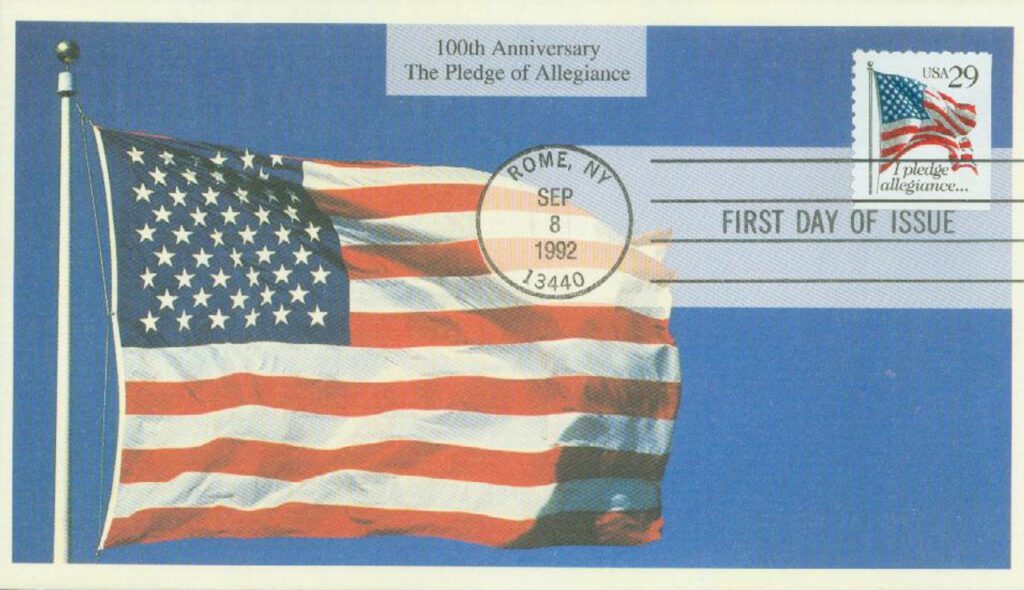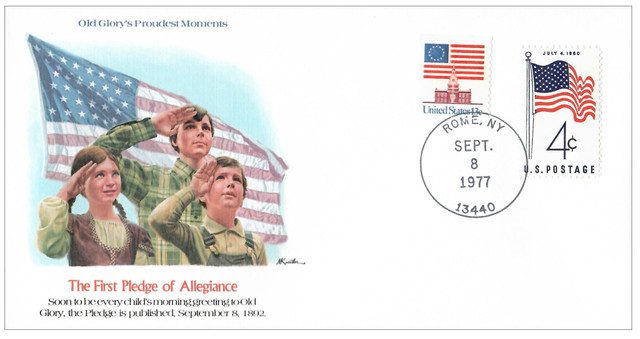
On June 22, 1942, Congress formally adopted the Pledge of Allegiance.
Francis Bellamy wrote the pledge. Bellamy was born in 1855 and raised in Rome, New York, where his father, David, was the pastor of the First Baptist Church.

In 1884, Bellamy accepted a position with the Dearborn Street Church in Boston. While in Boston, Bellamy was part of a national committee that formed to foster patriotism in schools in conjunction with the 400th anniversary of Columbus’ discovery of America. James Upham of The Youth’s Companion magazine saw the event as an opportunity to support his goal of placing flags in every school in America.
Bellamy was tasked with writing a brief salute to be recited as the flag was raised. Though the result was just 23 words, Bellamy labored over every one of them, ensuring the final pledge would be both concise and meaningful. He penned the pledge on September 7, and it was published the following day:
“I pledge allegiance to my Flag and to the Republic for which it stands; one Nation, indivisible, with Liberty and Justice for all.”
A month later, the pledge was recited for the first time by over 12 million school children on Columbus Day. The pledge soon became a daily exercise at most American schools. It was over 30 years before adults began using the words to affirm their patriotism. The 1923 National Flag Conference made it popular with adults. After that, the pledge became commonplace in meetings and events throughout the country.
On June 22, 1942, Congress formally adopted the pledge as part of the US Flag Code. And in 1945, the official name, “Pledge of Allegiance,” was adopted.
Though its ideals are still the same, the wording has changed over the years. In 1923, the phrase “the flag of the United States of America” replaced “my Flag,” to distinguish it from the flags of other nations. The words “under God” were added in 1954, taken from Lincoln’s Gettysburg Address, but some have questioned the inclusion citing the separation of church and state.
Perhaps the most unusual change came not in the wording, however, but in the salute that Bellamy devised to be used during the pledge. In 1942, this straight-arm salute was dropped when the Nazi Party in Germany began using it. It was changed to placing a hand over the heart. The pledge, as it has remained since 1954, is “I pledge allegiance to the Flag of the United States of America, and to the Republic for which it stands, one Nation under God, indivisible, with Liberty and Justice for all.”

| FREE printable This Day in History album pages Download a PDF of today’s article. Get a binder or other supplies to create your This Day in History album. |
Discover what else happened on This Day in History.






This brings back a lot of great memories to me grown up. While in Elementary School, every morning we started with a scripture reading and reciting the Pledge of Allegiance. We we stood proudly as we recited those words. Ah, those were wonderful days.
I read all the wonderful historical narratives you post.
I remember saying the pledge of allegiance in grammar school and up to the 8th grade. It brings back fond memories as this was 65 years ago.
If you were one of us who attended school during the 50’s you can remember reciting the pledge of allegiance and reading bible scriptures proudly at the beginning of the school day. Those were good days and I was pleased this year to hear my grandchildren reciting the pledge at the beginning of their virtual day in school this past year. I hope this will continue and reading bible scriptures will be reinstated.
The reading of bible scriptures will not be reinstated. What may have been acceptable and appropriate in earlier days is no longer acceptable or appropriate.
It has been said that what is happening in schools today from elementary to
college, can be attributed to the removal of scripture reading and prayer.
Most of us have no idea what you are talking about. I will say that “what is happening in schools today,” is that it is more inclusive of all students and more appropriate to the challenges the students will face in the future. I say this as a high school and elementary teacher for more than 40 years.
Thank You Mr. Gaunt for your service as a teacher to the younger generation who keep improving our world today. If it wasn’t for the nasty roll of conservatives like those in this article holding them back, who knows where the young could take us. Ten Commandments in schools? I am a believer in GOD, but please keep your beliefs at home and church, not in self-serving laws. We always have been a nation of diversified people, thinkers, freedom’s and religion’s that has made us the envy of people all around the globe! Liberty and Justice for ALL!
In the original version, the words “one nation indivisible” were important to emphasize that we are one nation. When he wrote it, the Civil War was still recent history, emphasizing our division as a nation. The placing of “under God ” between the words “under God” took away that memory. I suspect that Bellamy would not be pleased with that placing.
allegiance to the flag is why it should never be burned